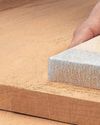Versuchen GOLD - Frei
HOW TO BUILD A ROCKET STOVE
The Home Handyman
|Jul/Aug'25
Most of our household energy requirements come in the form of space heating, water heating or cooking, with these making up a large percentage of our monthly bill. Rocket stoves are an example of appropriate technology which can cover all of those needs, cost you next to nothing to build, and just a few twigs to run.
-

Fuel is burned in a simple combustion chamber containing a vertical chimney, which ensures almost complete combustion prior to the flames reaching the cooking surface.
Tools and materials needed
Materials:
- Steel tubing (100 – 150mm diameter):
- A: 1x vertical riser (460 – 600mm)
- B: 1x diagonal fuel feed tube (450mm)
- C: 1x Horizontal air intake (450mm)
- 4x Round bar legs (200mm)
- Expanded metal mesh (optional for pot stand)
- Insulating material (optional): perlite, ash, or vermiculite
Tools:
- Angle grinder (with cutting & grinding discs)
- Welding machine and safety gear (helmet, gloves, jacket)
- Drill and metal bits (if screwing instead of welding)
- Measuring tape and marker
- Clamps and square (for alignment)
- Wire brush or flap disc (for smoothing edges)
Here's a step-by-step guide to building a metal rocket stove using steel tubing, a durable, efficient cooking solution ideal for camping, emergency use, or off-grid living.
Step 1: Cut Your Metal Tubing
• Cut vertical riser: 460 - 600mm
• Cut diagonal feed pipe: 450mm
• Cut horizontal air intake: (450mm)
• Cut 4x round bar legs (200mm)
• Cut expanded metal mesh 300x300mm
Tip: Clean and de-burr all edges with a grinder to ensure safe handling and better welds.
Step 2: Create the L-Shape Burn Chamber
• Weld the diagonal feed tube (B) into the vertical riser (A) at an 45° angle.
• Weld the horizontal air intake (C) into the vertical riser (A) at 90°.
Diese Geschichte stammt aus der Jul/Aug'25-Ausgabe von The Home Handyman.
Abonnieren Sie Magzter GOLD, um auf Tausende kuratierter Premium-Geschichten und über 9.000 Zeitschriften und Zeitungen zuzugreifen.
Sie sind bereits Abonnent? Anmelden
WEITERE GESCHICHTEN VON The Home Handyman

The Home Handyman
KEEP YOUR HOUSE CRITTER FREE
With winter fast approaching, outdoor critters seeking to regulate their temperature are trying their best to get inside. Ants, spiders, moths, mosquitoes, fruit flies, stink bugs, termites, silverfish, and ladybugs, to name a few, can easily make their way into homes, and once they've settled in, it's often hard to get them out.
6 mins
Jul/Aug'25

The Home Handyman
SECRET HIDEOUTS
We all have things we would prefer to keep out of plain sight - family heirlooms, wedding rings, expensive jewellery, medicines or even weapons. Sometimes we just want to keep household items hidden in order to declutter a space. Whether you want to hide items for safety or financial reasons, or simply want to keep your bedroom tidy, there are a few clever storage ideas that could help you out.
2 mins
Jul/Aug'25

The Home Handyman
ABRASIVES DEMYSTIFIED
Abrasive materials are indispensable in countless industries, from woodworking and metal fabrication to automotive repair and electronics manufacturing.
3 mins
Jul/Aug'25

The Home Handyman
THINNERS VS. TURPENTINE
If you've ever finished a painting or staining job and been left wondering how best to clean your brushes, you're not alone. One of the most common DIY questions is: Should I use thinners or turpentine to clean my brushes? The answer depends on the type of paint or coating you've used. Using the wrong solvent can damage your brushes, or worse, make the cleaning job even harder.
2 mins
Jul/Aug'25

The Home Handyman
KEEP THE COLD OUT
Did you know that homes in South Africa are either insulated to a poor standard, compared to European nations, or have no form of insulation at all. In 2011 our National Building Regulations made it compulsory to fit thermal insulation in new buildings and additions to building structures.
5 mins
Jul/Aug'25

The Home Handyman
ANGLE GRINDERS — MASTERING THIS VERSATILE TOOL
When it comes to versatile tools in a DIYer's arsenal, few can match the power and practicality of the angle grinder.
2 mins
Jul/Aug'25

The Home Handyman
KITCHEN CARE – MAINTENANCE TIPS FOR KEY AREAS
The kitchen is the heart of the home where meals are made, memories are shared, and chaos sometimes reigns. But like any hardworking space, your kitchen needs regular maintenance to keep it functional, safe, and looking great.
2 mins
Jul/Aug'25

The Home Handyman
Separating Fact from Fiction
Maintaining your home can be a daunting task, especially with the plethora of DIY tips and tricks floating around the internet.
2 mins
Jul/Aug'25

The Home Handyman
SEALANTS SIMPLIFIED: WHAT TO USE AND WHERE
Whether you’re tackling a weekend DIY fix, remodelling your home, or involved in large-scale construction, sealants are a silent hero that play a vital role in creating watertight, airtight, and secure finishes.
3 mins
Jul/Aug'25

The Home Handyman
COMMON FRIDGE/FREEZER FAULTS
Your fridge freezer is one of the hardest-working appliances in your home, so when it stops performing as it should, it can cause major inconvenience. The good news? Not every fault means an expensive call-out or a trip to the shops for a new one. In many cases, you can fix the issue yourself with a little know-how and a few basic tools.
3 mins
Jul/Aug'25
Listen
Translate
Change font size
